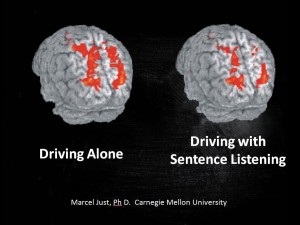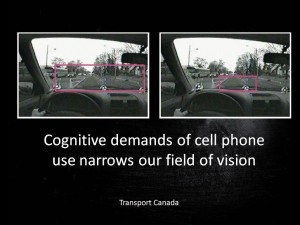Reprinted from:
The Legal Examiner
 Posted by Joel Feldman, Esq.*
Posted by Joel Feldman, Esq.*
October 2, 2015
Distracted driving crashes are receiving more and more attention. Much of the focus has been on texting, and more recently on using all the other apps and features of our phones, including Facebook, Twitter, Snapchat, and Instagram.
But what has not received much attention is the dangerous distractions being built into our cars. Car manufacturers are designing and building cars and installing voice-activated features that are promoted as being safer. The argument seems to be if you don’t need to take your eyes off the road to do something, then it’s safe. So drivers can now access Facebook, read and send texts and e-mails, and even access stock quotes while driving using voice commands.
Unfortunately, the premise that “hands-free is risk-free” is not supported by research. In fact, research continues to show that people are not good multi-taskers, and that even when we are looking at the road, our driving performance suffers if we try to do too many things at the same time.
 The study of the dangers of cognitive distraction while driving is not new, and car manufacturers are ignoring that body of evidence to try to sell more cars. When manufacturers sell dangerous products that cause injuries to consumers, they can be held liable under various products liability laws throughout the U.S. Often, it is through product liability lawsuits that manufacturers decide to make their products safer.
The study of the dangers of cognitive distraction while driving is not new, and car manufacturers are ignoring that body of evidence to try to sell more cars. When manufacturers sell dangerous products that cause injuries to consumers, they can be held liable under various products liability laws throughout the U.S. Often, it is through product liability lawsuits that manufacturers decide to make their products safer.
Is a car equipped with voice-texting technology dangerous, and should the manufacturer of the car be held liable if that feature causes a crash and injuries? That question was examined in a recent workshop I moderated at the 3rd Annual Virginia Distracted Driving Summit. This issue is of vital concern to me, not only as an attorney, but also as a traffic safety advocate working to reduce distracted driving and save lives.
The following is taken from an expert witness’ report:
 “With respect to cognitive distractions my research and that of others has demonstrated that humans are not good multi-taskers, and when secondary tasks, like having cell phone conversations or reading and composing texts-even hands-free -are attempted by drivers crash risk increases because of the added cognitive demand. With respect to our inability to safely multi-task when cognitively distracted, research in our laboratory and elsewhere has shown that when drivers engage in hands-free cell phone conversations their brains adjust to the added cognitive demands by allocating resources way from those areas of the brain responsible for vision to areas responsible for cognition, resulting in a 37% loss of brain resources previously allocated for safe driving. Additional research has demonstrated what I call “tunnel vision,” or a narrowing of our visual field by reduced scanning when a cognitively demanding cell phone conversation is introduced when driving… [Automobiles which incorporate these dangerous technologies are not safe.]”
“With respect to cognitive distractions my research and that of others has demonstrated that humans are not good multi-taskers, and when secondary tasks, like having cell phone conversations or reading and composing texts-even hands-free -are attempted by drivers crash risk increases because of the added cognitive demand. With respect to our inability to safely multi-task when cognitively distracted, research in our laboratory and elsewhere has shown that when drivers engage in hands-free cell phone conversations their brains adjust to the added cognitive demands by allocating resources way from those areas of the brain responsible for vision to areas responsible for cognition, resulting in a 37% loss of brain resources previously allocated for safe driving. Additional research has demonstrated what I call “tunnel vision,” or a narrowing of our visual field by reduced scanning when a cognitively demanding cell phone conversation is introduced when driving… [Automobiles which incorporate these dangerous technologies are not safe.]”
When car manufacturers design dangerous distracting technologies into vehicles, they should be held responsible in order to better protect consumers. Hopefully, it will not take too may crashes and tragedies before manufacturers decide that it is just not safe to facilitate drivers’ texting or accessing the internet when driving.
*About Joel Feldman
Anapol Weiss Partner Joel Feldman founded End Distracted Driving (EndDD.org) after his daughter Casey was killed by a distracted driver in 2009. EndDD.org promotes driver safety through a scientifically-based distracted driving presentation that has been given by hundreds of lawyers, nurses, physicians, safety experts and other professionals.





